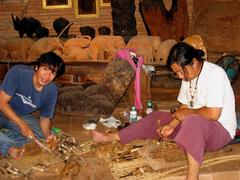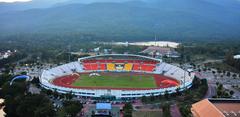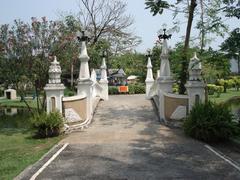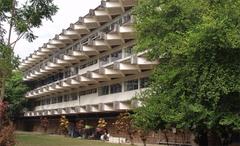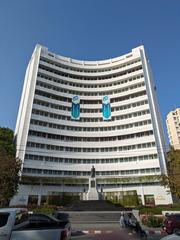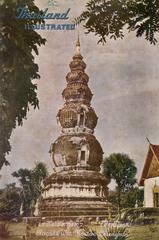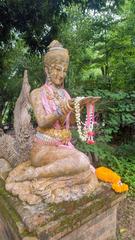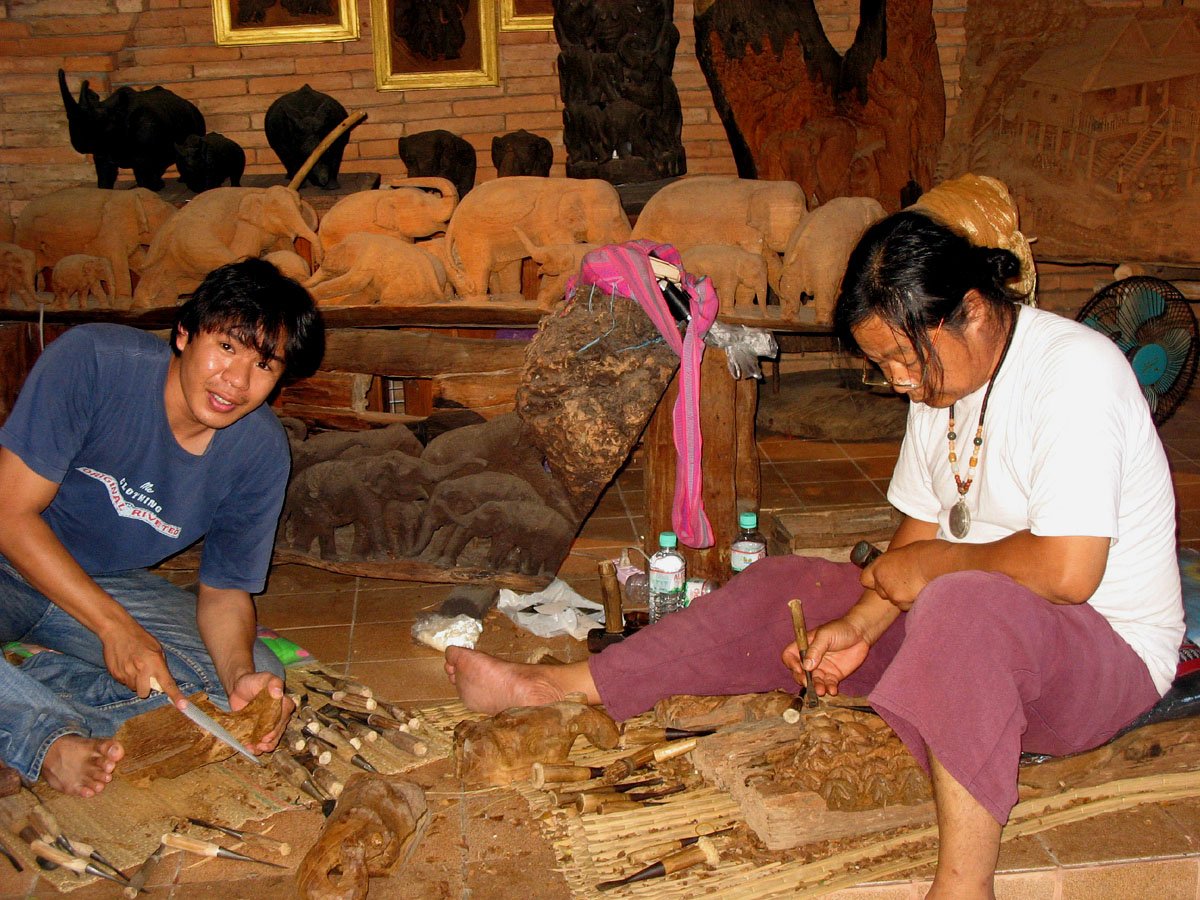
Visiting Wat Lok Moli: Hours, Tickets, and Travel Tips
Date: 18/07/2024
Introduction
Nestled within the historical landscape of Chiang Mai, Wat Lok Moli is a compelling testament to the city’s enduring spiritual and architectural heritage. Founded during the 14th century under King Kue Na of the Mengrai dynasty, this temple has seen periods of royal patronage, decline, and revival, mirroring the broader historical narrative of Chiang Mai itself (Chiang Mai Citylife). Wat Lok Moli is renowned for its distinct Lanna architectural style, characterized by its towering chedi and intricate stucco work, which symbolize the Buddha’s enlightenment and house sacred relics (Lonely Planet). The temple also served as a center of Buddhist scholarship and meditation, reflecting its significant religious and cultural role in the region (Renown Travel). This guide aims to provide you with an essential overview of Wat Lok Moli, including its history, architectural marvels, visiting tips, and nearby attractions, ensuring you have a memorable and respectful visit.
Table of Contents
- [History](#historyhistory)
- [Early Beginnings and Royal Patronage](#early-beginnings-and-royal-patronageearly-beginnings-and-royal-patronage)
- [Expansion and Transformation](#expansion-and-transformationexpansion-and-transformation)
- [Challenges and Renewal](#challenges-and-renewalchallenges-and-renewal)
- [Modern Revival and Contemporary Significance](#modern-revival-and-contemporary-significancemodern-revival-and-contemporary-significance)
- [Visiting Wat Lok Moli](#visiting-wat-lok-molivisiting-wat-lok-moli)
- [Visitor Information](#visitor-informationvisitor-information)
- [Travel Tips](#travel-tipstravel-tips)
- [Nearby Attractions](#nearby-attractionsnearby-attractions)
- [Architectural Marvels](#architectural-marvelsarchitectural-marvels)
- [The Grand Viharn (Prayer Hall)](#the-grand-viharn-prayer-hallthe-grand-viharn-prayer-hall)
- [The Ancient Chedi](#the-ancient-chedithe-ancient-chedi)
- [The Ordination Hall (Ubosot)](#the-ordination-hall-ubosotthe-ordination-hall-ubosot)
- [The Serene Atmosphere](#the-serene-atmospherethe-serene-atmosphere)
- [Discovering Hidden Gems](#discovering-hidden-gemsdiscovering-hidden-gems)
- [FAQ](#faqfaq)
- [Conclusion](#conclusionconclusion)
- [References](#referencesreferences)
History
Early Beginnings and Royal Patronage
The temple’s origins can be traced back to the 14th century, during the reign of King Kue Na (1355-1385) of the Mengrai dynasty. While the exact date of its founding remains uncertain, local chronicles suggest that it was established around 1367. King Kue Na, known for his devout Buddhism, chose a site just outside the city walls, amidst a grove of lok moli trees (coral jasmine), which lent the temple its name.
Wat Lok Moli quickly rose to prominence, becoming a favored meditation retreat for King Kue Na and subsequent rulers. The temple’s serene ambiance, fostered by its lush surroundings and proximity to the city’s moat, made it an ideal location for spiritual contemplation.
Expansion and Transformation
The late 15th and early 16th centuries witnessed a period of significant growth and transformation for Wat Lok Moli. Under the patronage of King Muang Kaeo (1495-1525), the temple underwent extensive renovations and expansions. The towering chedi, a distinctive feature of Lanna architecture, was likely constructed during this era, its imposing structure symbolizing the Buddha’s enlightenment and serving as a reliquary for sacred objects.
King Muang Kaeo’s reign also saw the establishment of a Buddhist university within the temple grounds. This institution, attracting scholars and monks from across the Lanna Kingdom and beyond, solidified Wat Lok Moli’s reputation as a center of learning and religious discourse.
Challenges and Renewal
The following centuries brought about a period of instability and decline for both Chiang Mai and Wat Lok Moli. The Burmese conquest of the city in 1558 led to the abandonment of many temples, including Wat Lok Moli. The once-vibrant monastic community dwindled, and the temple’s structures fell into disrepair.
However, Wat Lok Moli was not forgotten. Following the Burmese expulsion in 1775, efforts to restore the temple commenced. New structures were added, and existing ones were repaired, reflecting both the enduring reverence for the site and the evolving architectural styles of the era.
Modern Revival and Contemporary Significance
In the 20th century, Wat Lok Moli experienced a resurgence of interest and support. Recognizing its historical and cultural significance, the Fine Arts Department of Thailand undertook major restoration projects, aiming to preserve the temple’s architectural heritage for future generations.
Today, Wat Lok Moli stands as a captivating blend of ancient and modern. The meticulously restored chedi, with its intricate stucco work and towering presence, serves as a reminder of the temple’s glorious past. The viharn, or assembly hall, houses a revered Buddha image, its serene countenance drawing devotees and visitors alike.
Beyond its architectural splendor, Wat Lok Moli remains an active place of worship and community life. Monks reside within the temple grounds, their presence a tangible link to the site’s long monastic tradition. Locals and tourists alike visit Wat Lok Moli to pay their respects, meditate, or simply soak in the tranquil atmosphere.
Visiting Wat Lok Moli
Visitor Information
- Visiting Hours: Wat Lok Moli is open daily from 6:00 AM to 6:00 PM, allowing visitors ample time to explore the grounds and soak in its serene atmosphere.
- Tickets: There is no entrance fee to visit Wat Lok Moli, but donations are welcome and help with the maintenance of the temple.
Travel Tips
- Dress Code: Modest attire is required. Shoulders and knees should be covered as a sign of respect.
- Best Time to Visit: Early mornings or late afternoons are ideal to avoid the midday heat and crowds.
- Photography: The temple offers numerous photographic spots, especially around the chedi and viharn. However, always be respectful and avoid disrupting worshippers.
Nearby Attractions
Wat Lok Moli is conveniently located near other historical sites in Chiang Mai, such as Wat Phra Singh and Wat Chedi Luang, making it easy to include in a day of temple hopping.
Architectural Marvels
The Grand Viharn (Prayer Hall)
The main prayer hall, or viharn, is a modern addition to the temple complex, built in 1992. Inside, you’ll find the stunning 40-meter-long reclining Buddha statue and intricate murals depicting scenes from the life of Buddha and Jataka tales.
The Ancient Chedi
Dominating the temple grounds is the towering Lanna-style chedi that dates back to the 16th century. Standing tall at 40 meters, the chedi’s architectural splendor and historical significance make it a focal point of Wat Lok Moli.
The Ordination Hall (Ubosot)
The ubosot, or ordination hall, is the most sacred building within the temple complex. While access inside may be restricted, its exterior architecture with distinctive Lanna features is worth admiring.
The Serene Atmosphere
Beyond the architectural marvels, Wat Lok Moli exudes a palpable sense of peace and tranquility. The sprawling grounds, dotted with ancient trees and shaded pavilions, provide a welcome respite from the bustling city.
Discovering Hidden Gems
Take some time to explore the nooks and crannies of the temple complex. You’ll discover hidden gems such as ancient Buddha images, stone inscriptions, and tranquil gardens.
FAQ
Q: What are the visiting hours for Wat Lok Moli? A: Wat Lok Moli is open daily from 6:00 AM to 6:00 PM.
Q: Is there an entrance fee to visit Wat Lok Moli? A: No, there is no entrance fee, but donations are welcome.
Q: What should I wear when visiting Wat Lok Moli? A: Modest attire is required. Shoulders and knees should be covered as a sign of respect.
Q: Are there any special events or guided tours available at Wat Lok Moli? A: Yes, occasionally there are special events and guided tours. It is recommended to check with the temple or local tour operators for more information.
Conclusion
Visiting Wat Lok Moli offers a profound journey into the spiritual and cultural heart of Chiang Mai. The temple’s rich history, from its 14th-century origins to its modern-day significance, provides a unique glimpse into the resilience and faith that have shaped this sacred site. The meticulously restored chedi and viharn stand as testaments to Lanna craftsmanship and Buddhist devotion, inviting visitors to reflect on the enduring legacy of this remarkable temple (Chiang Mai Best). As you wander through the tranquil grounds, take a moment to appreciate the serene atmosphere, engage with the local culture, and perhaps participate in a monk chat or meditation session. The nearby historical sites such as Wat Phra Singh and Wat Chedi Luang further enrich your cultural exploration of Chiang Mai (Travelfish). Whether you are a history enthusiast, a spiritual seeker, or a curious traveler, Wat Lok Moli promises a deeply enriching experience that will leave a lasting impression. For more insights and updates on exploring Chiang Mai’s historical treasures, follow our blog, download our mobile app, or connect with us on social media.
